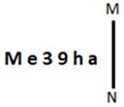Select the correct mirror image of the given figure when the mirror is placed at MN.
A paper is folded and cut as shown below. How will it appear when unfolded?
Identify the figure given in the options which when put in place of ? will logically complete the series.